Wiener Schnitzel is an Austrian main dish made with veal. The meat is pounded into thin slices, breaded, and fried and is then served with lemon wedges and greens for garnishment.
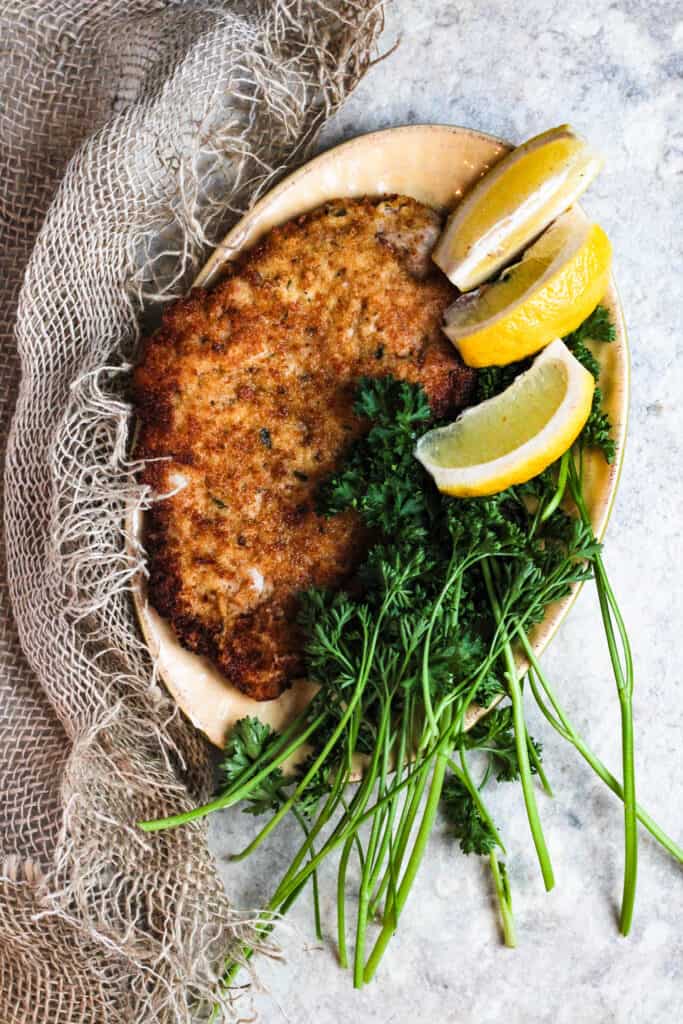
Hello Reader! I try my hardest to research recipes as best as I can before posting to ensure I am representing each culture correctly. If this recipe is from your country and I have made a mistake or you have suggestions for how to make it more authentic, I would love to hear! Please leave a comment below letting me know what should be different, and I will rework the recipe. It is always my intention to pay homage and respect to each cultural dish that I cook. Thanks for reading!
When I think of food in Austria, the very first thing that comes to mind is Wiener Schnitzel. This stuff is EVERYWHERE.
In every restaurant, on every dinner menu in Austria, Wiener Schnitzel is always an option.
Maybe I was eating at places that catered to tourists? But from my experience, there wasn’t a restaurant that didn’t serve this Austrian specialty.
Wiener Schnitzel is a thin cut of veal that has been tenderized, coated loosely in bread crumbs, and then deep fried to create a dish that is crispy, juicy and somehow still light and delicate when served with a side of fresh slices of lemon and greens.
The veal is the most important part of this delicious dish and there are even laws in Austria and Germany that say the dish cannot be called Wiener Schnitzel if it is not made with veal.
Creating this national dish of Austria at home takes some skill, but if you have never tried cooking veal before, this is the best way!
Recipe Origins
Wiener Schnitzel is the national dish of Austria, but the origin of the dish is up for some debate.
There is historical proof of Ancient Romans tenderizing, breading and frying meat as early as the first century. The Romans may then have brought this recipe to the Germanic region during war times.
Milan, Italy has “Cotoletta alla Milanese”, a dish that is exactly the same as Wiener Schnitzel but with the bone left in the meat. It was popular long before Wiener Schnitzel came to Austria and remains a signature dish of Milan today.
A popular story goes that in 1857 a general in the Austrian army, Joseph Radetzky, was reporting to the Austrian emperor on Italian territories and mentioned a delicious steak he had tried.
The emperor was curious and asked for the recipe. From there, it spread like wildfire.
By the middle ages, Schnitzel had become incredibly popular in Germanic areas and what is currently Austria.
Austrian law is so protective of the recipe, it says that only veal can be called a Schnitzel.
Why Make this Recipe
- Very Simple: What could be easier than breading some meat and frying it up? Making this simple recipe is easy and delicious!
- Tender and Delicious: Veal is naturally tender but by pounding it thin, it is made to melt in your mouth.
- “Travel” to Austria: If you want to close my eyes and imagine you’re in Austria, eating Wiener Schnitzel is the way to do that. I ate my fair share of this dish while in Austria, and it is, for good reason, the quintessential food for experiencing Austrian culture.
What Do I Need to Make This Recipe
Ingredients
Here is a visual overview of the ingredients in the recipe. Scroll down to the recipe at the bottom for quantities.
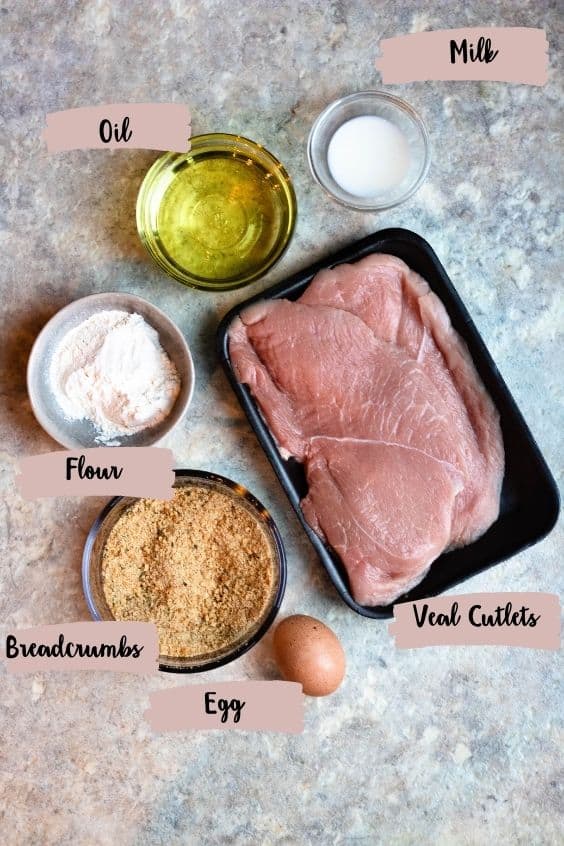
- Veal Cutlets: You can find veal meat cutlets at your local butcher. These should be boneless and very thin. You can also use scallopini if you want a really thin piece of meat!
- Breadcrumbs: Traditionally, this dish is mainly made with plain breadcrumbs but if you want to add some flavor, you can add Italian breadcrumbs.
- Oil: Use whatever oil you like to use for frying. I try to stick with sunflower oil, peanut oil or vegetable oil. Use oils with a high smoking point (olive oil is not a good option).
Tools
- Three Large Shallow Bowls
- Large Deep Skillet
How to Make this Recipe
Step 1: Prepare the Meat
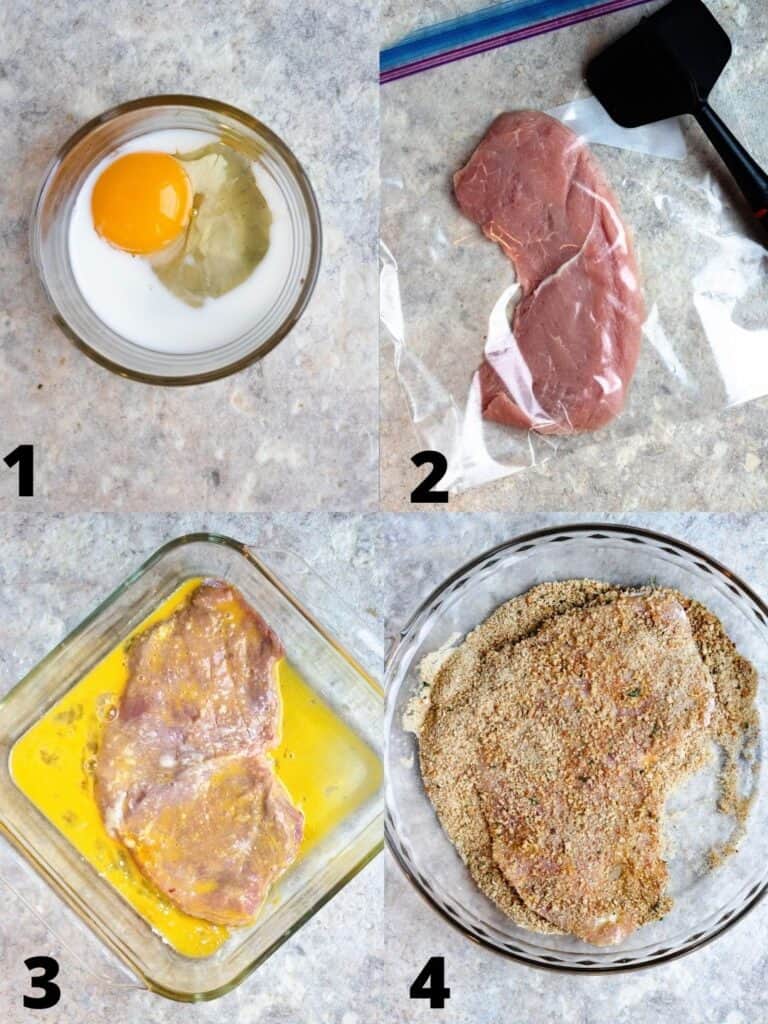
Use a meat tenderizer or meat mallet to pound the meat to ¼ of an inch. This is very important, as it will keep your meat from tensing up as it gets hot.
Step 2: Coat the Meat
Combine the milk and the eggs and whisk together in a large, wide bowl.
Put enough oil in the pan to come about halfway up the meat cutlet. Heat the oil until it reaches 350 degrees.
Dip each of the cutlets into the flour. Then dip them into the egg and then the third wide shallow bowl of breadcrumbs to coat.
Step 3: Fry the Meat
Put each breaded veal cutlet in the pan (I fried them one at a time). Cook for about two minutes, flip, and then cook for about two minutes on the other side until golden brown. The cutlets should be a minimum of 145 degrees Fahrenheit.
Transfer slices of Wiener Schnitzel from the hot oil and place on a large plate or large baking sheet lined with a double layer of paper towels to drain oil.
Squeeze lemon slices onto the meat and enjoy!
Enhancements
There are some ways to enhance your Wiener Schnitzel. Though they are not traditional, they are a great way to add more flavor or a different taste profile to your dish!
- I sometimes use Italian seasoned breadcrumbs to make this recipe.
- You could also add some seasoning or a teaspoon of salt to your flour mixture
- Another non-traditional, yet delicious option is to mix some parmesan cheese into the breadcrumbs before frying.
Expert Tips
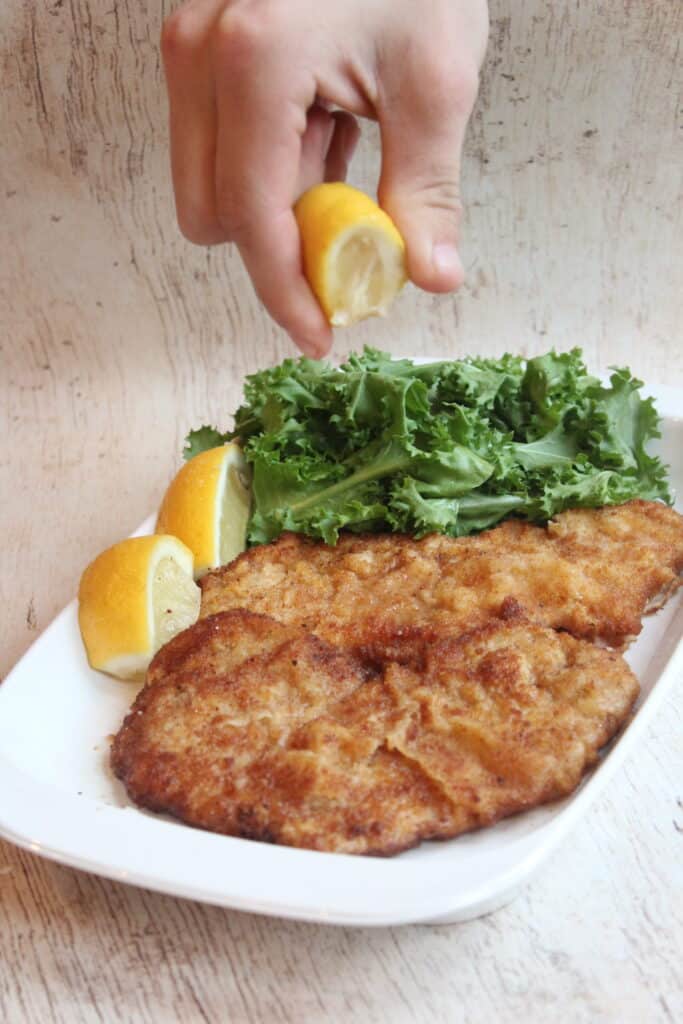
- Pounding the meat helps to tenderize it. Even if your meat is cut thin, you should still pound it/
- Be sure and beat your eggs until light and fluffy before using them to coat your veal.
- Do not press the breadcrumbs into the meat, as this will moisten them and make your coating soggy. Once cooked, your coating should be loose on the meat.
- For the best results, fry your cutlets immediately after applying the bread crumbs. Do not let them sit in the bread crumbs or it will make the crumbs soggy.
- If you are making several wiener schnitzels, keep them warm in the oven on a wire rack at a very low temperature until they are ready to eat.
- Serve your Wiener Schnitzel with a slice of lemon and a side of parsley to garnish your dish!
Frying Tips
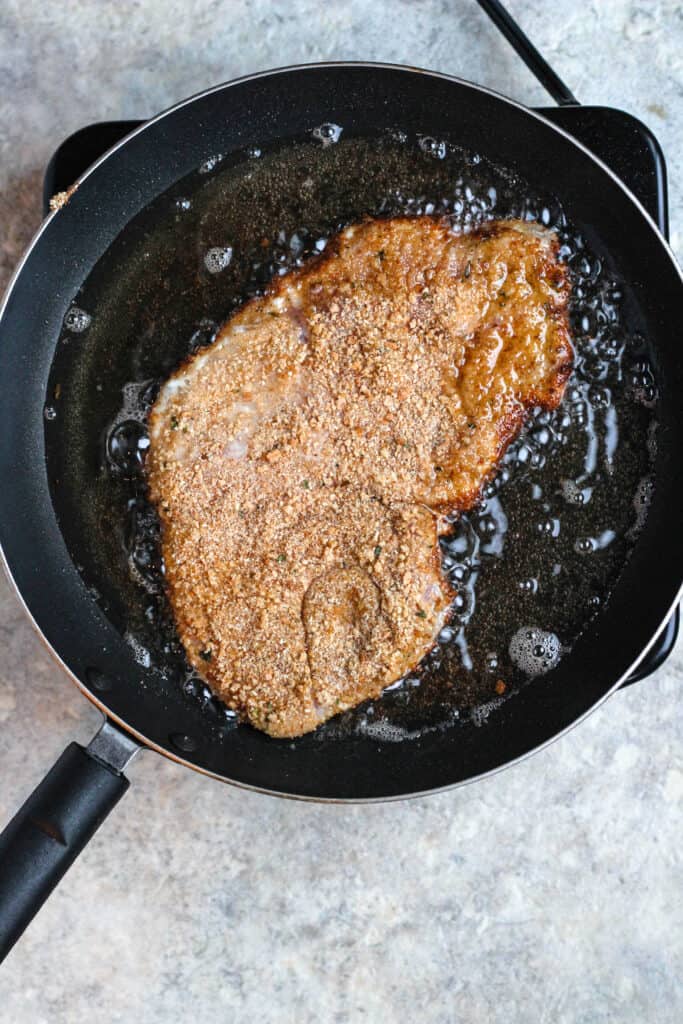
Frying can be tricky, so make sure to follow these tips to get the perfect cook on your Wiener Schnitzel!
- Lard is the traditional method for frying this dish, though oil could be simpler for those making this recipe in the United States.
- It is important not to crowd your pan during the frying. The meat should be swimming in the oil during frying and not sticking to the pan. This helps the crust to become lighter and it actually retains less oil.
- The right heat for the oil is important. If it is too hot the coating will cook too quickly and if it is too cold your bread crumbs will become soggy.
- Bring the oil temperature back to 350 degrees Fahrenheit between each batch.
Recipe FAQs

Wiener Schnitzel is a piece of veal that is pounded thin, breaded, and then fried. It’s normally served with a wedge of lemon, some greens for garnishment, and, occasionally, potato salad on the side.
The word “Wiener” in the name actually refers specifically to a schnitzel that originated in Vienna, the capital of Austria.
The name “Wiener Schnitzel” is trademarked and protected, meaning that only schnitzels made with veal can be called a Wiener Schnitzel. Pork schnitzel is popular in Germany and different meats like chicken breast have been used, but only veal is the right type of meat for authentic wiener schnitzel.
Surprisingly enough (at least it was surprising to me), Wiener Schnitzel is not typically served with any sides in Austria. If there is a side, it’s normally some roasted potatoes or French fries.
However, if you are making this dish at home and want to serve it up with a delicious side, some great options would be mashed potatoes (you can even serve them up with horseradish!). This spinach salad would also be a great option.
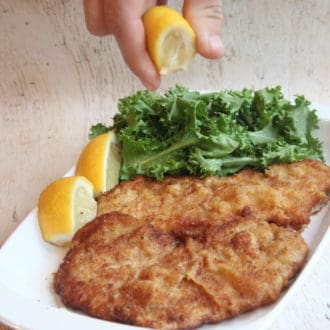
Wiener Schnitzel
Equipment
- Shallow Bowl(s)
- Skillet
- Whisk
- Paper Towel
Ingredients
- 4 veal cutlets
- 1 tbsp milk
- 1 egg
- ½ cup flour
- 1 cup plain bread crumbs
- vegetable oil for frying
- lemon slices for garnishment
- parsley for garnishment
Instructions
- Use a meat tenderizer to pound each of the 4 meat cutlets to ¼ of an inch. This is very important, as it will keep your meat from tensing up as it gets hot.
- Combine 1 tbsp milk and the 1 egg and whisk together.
- Put enough oil in the pan to come about halfway up the meat. Heat the oil until it reaches 350 degrees.
- Dip each of the cutlets into the flour. Then dip them into the egg and then the cup of breadcrumbs to coat.
- Put each cutlet in the pan (I fried them one at a time). Cook for about two minutes, flip, and then cook for about two minutes on the other side.
- Remove wiener schnitzel from the oil and place on a paper towel lined plate to drain oil.
- Squeeze lemon onto the meat and enjoy!
Notes
- Veal Cutlets: You can find veal meat cutlets at your local butcher. These should be boneless and very thin. You can also use scallopini if you want a really thin piece of meat!
- Breadcrumbs: Traditionally, this dish is mainly made with plain breadcrumbs but if you want to add some flavor, you can add Italian breadcrumbs.
- Oil: Use whatever oil you like to use for frying. I try to stick with sunflower oil, peanut oil or vegetable oil. Use oils with a high smoking point (olive oil is not a good option).
- Pounding the meat helps to tenderize it. Even if your meat is cut thin, you should still pound it.
- Be sure and beat your eggs until light and fluffy before using them to coat your veal.
- Do not press the breadcrumbs into the meat, as this will moisten them and make your coating soggy. Once cooked, your coating should be loose on the meat.
- For the best results, fry your cutlets immediately after applying the bread crumbs. Do not let them sit in the bread crumbs or it will make the crumbs soggy.
- If you are making several wiener schnitzels, keep them warm in the oven on a wire rack at a very low temperature until they are ready to eat.
- Serve your Wiener Schnitzel with a slice of lemon and a side of parsley to garnish your dish!
Nutrition
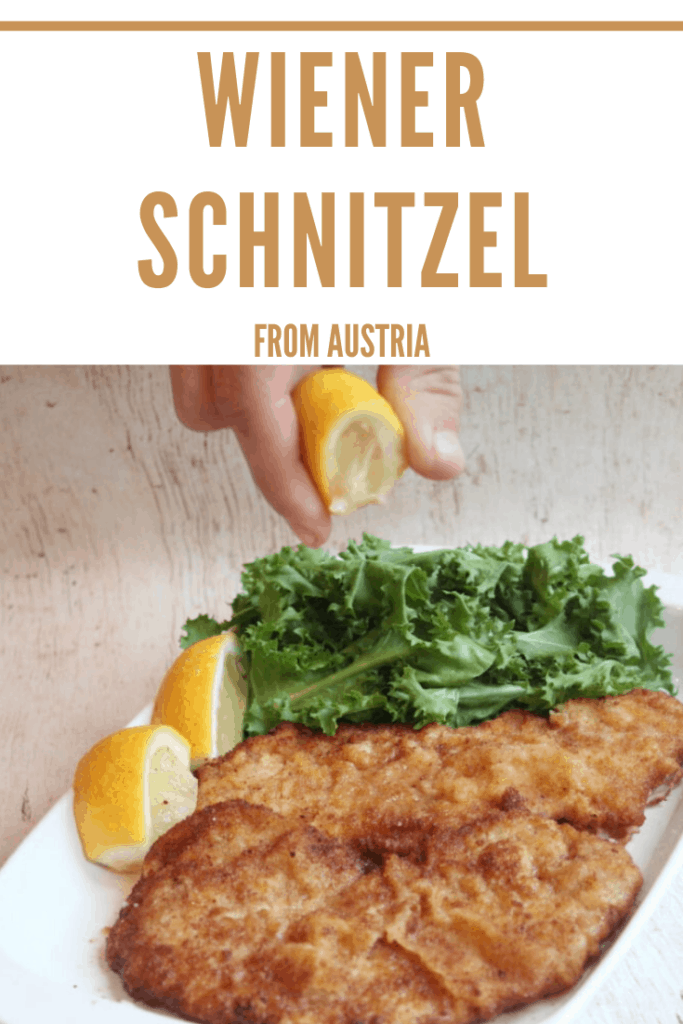



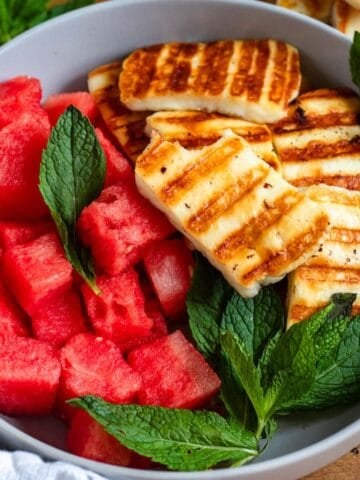



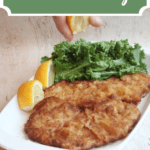

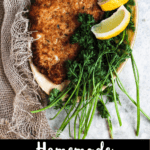





Ella says
Austrian here.
I love the disclaimer at the top of the recipe. 🙂 So I thought I’d comment.
All in all, you explained it very well and there’s nearly nothing to complain about, even for a grumpy Austrian. 😉
Just three minor things:
1. You apparently don’t use flour. The Schnitzel is first coated in flour, then in eggs, then in bread crumbs.
2. We don’t use milk.
3. We don’t serve Schnitzel with greens. Just a slice of lemon (tastes good and helps with digestion), lingonberry/cranberry jam on the side (!) of the plate (but that’s different for everyone – I love Schnitzel with lingonberry jam, my husband hates it) and either potato salad or “Petersilerdäpfel”, boiled potatoes with parsley: boil small potatoes in salted water, peel them, put them in a pot with a good amount of butter and chopped parsley, mix it all together on medium heat for a few minutes and done.
Other than that – a perfect recipe. 🙂
Just a tip: If you don’t like veal (like me), you can use pork. It’s then called “Schnitzel Wiener Art”, which means something like Viennese-style Schnitzel.
And the thinner the meat, the better. A good Schnitzel is about 4mm thick, which is around 0.15 inch.
One thing many “not-Austrians” get wrong (and imo it’s something important to mention): never – NEVER – use any kind of sauce to drown the Schnitzel in and soak the good, crisp coating. This is something the Germans always do and is seen as aggravated assault. Ok, just kidding, but also kinda not. Schnitzel with sauce is really bad.
And you already mentioned it: the Schnitzel has to swim. I can’t stress how important this is to get a good Schnitzel. So many people (also mostly Germans) use just a tablespoon of oil. No! No.
And yes, cooking (or as we say: “baking”) the Schnitzel in lard is the best. If you can get your hands on lard, do it!
Much Love from Austria,
Ella